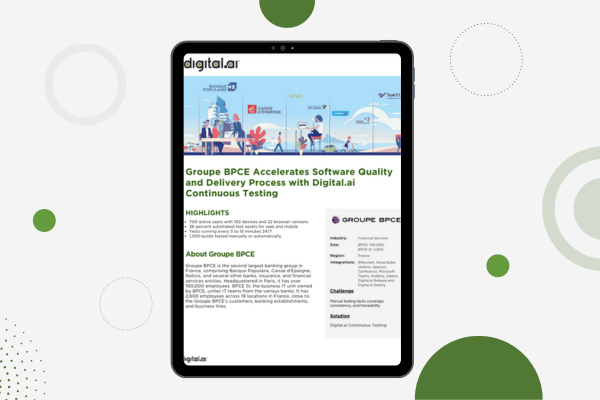What is Automated Testing?
Master automated testing for faster, more reliable software. Learn key concepts and best practices for efficient & maintainable tests.
Speed and quality are two of the most important aspects of software development and delivery. Web and mobile app users demand both and will abandon an application if it cannot provide either. Testing has always been a challenge in that a manual process is tedious and time consuming. The arrival of automated testing in the 2010s meant that the repetitive tasks developers and test automation tools were forced to undertake were now settled leaving more time for strategic analysis and innovation. Read this guide to take a deeper look into the world of test automation from core concepts and benefits to building frameworks, exploring tools, and navigating best practices.
What is Automated Testing?
It might sound like science fiction but in the simplest of terms Automated Testing is a tool or set of tools that help automate repetitive testing tasks. It allows developers and testers to focus on higher-level analysis and strategic thinking. Gone are the days of endless manual clicks and checks. An automated testing tool will execute an organization’s test cases and compare results with expected outcomes to deliver valuable insights while saving time, effort, and resources.
Automated testing, as robust as a process as it can be is not a replacement for Manual Testing. Both methods compliment each other and address different aspects of the web or mobile app under test. The combination of these approaches helps teams reach comprehensive test coverage while ensuring the quality of the final product.
Understanding the importance of Automated Testing
Web and mobile app development is getting faster. Customers demand frequently updated applications that also perform flawlessly. In this new order, manual software testing processes cannot keep up with the demand. This is especially true as AI generated code is used more frequently. The increase in developer productivity must be met with downstream improvements to eliminate any bottlenecks.
Automation Testing is crucial because it:
- Boosts Efficiency: Tedious regression testing projects are no more as automated tools take on the burden of repetitive tasks and free teams to focus on exploratory and creative development and automation testing innovations. The result is an increase in test coverage, while enabling the discovery of other potential issues early in the development process.
- Promotes Faster Feedback: Automated tests deliver immediate feedback in case of defects or issues. This helps reduce the time to market.
- Enhances Quality: Consistent and reliable results are key aspects of test automation. When human error is minimized consistent quality across all releases is assured, leading to a stable product with more satisfied customers.
- Improves Cost Effectiveness: When manual testing efforts are reduced it frees up resources and saves money. For example, the earlier in the development process a defect is discovered and mitigated the less costly it is overall.
Understanding the different types of automated testing
No toolbox contains only one wrench. No automated testing process contains only one approach. There are a myriad of testing types that can be automated and they all serve an important purpose. Let’s take a look at different automation testing types and see how they work together to improve development and testing processes as well as overall software quality.
- Integration Testing – Ensures that all software modules connect seamlessly. Running these tests simulates how the different modules interact checking of the transfer of data is correct and preventing communication breakdowns.
- Functional Testing – Focuses on the actual web and mobile app functionality and how it aligns with defined requirements. This type of testing verifies that software is performing tasks correctly and that the functionality promised to users is delivered accurately and one time.
- Regression Testing – Works almost as a safety net ensuring new changes do not break existing functionality. It guarantees a level of stability that keeps software running smoothly after every update. Simply put, successful regression testing means that no new features are causing issues for existing ones.
- Smoke Testing – Performs basic checks that confirm critical functionalities are working before executing more extensive automation testing. It serves as a quick sanity check that confirms essential features are working as intended.
- Performance Testing – Evaluates how web and mobile apps perform under load by examining factors like responsiveness resource usage and scalability. It also takes device vitals into account making sure that apps do not consume too much device battery or memory.
- Security Testing – Identifies potential security risks and addresses them to protect unauthorized access and user data.
- Accessibility Testing – Verifies that users of any ability have access to information, can navigate the UI and interact with the app using various assistive technologies like screen readers.
Building an Automated Testing Framework
This is a strategic process that has several key steps in it. The goal is to safeguard web and mobile app quality with the following:
1) Choosing the right tools. While the following tools are a small sample it is important to research and compare tools so you discover the best ones for your teams:
i. Selenium – Open source software testing tool that is ideal for automating web testing.
ii. Cypress – Is a modern and easy to use, web app testing tool with focus on developer experience.
iii. Appium – Works well for cross-platform mobile testing as it includes both native and mobile web applications.
iv. Robot – A flexible framework that is keyword driven and works well with teams that use Python or Java.
2) Designing test cases – This helps outline what organizations want to test and how they test it. It is most important to draft plans that are clear and comprehensive to give your automation process a firm foundation.
i. Clear Objectives – Start with a definition of what each test case should achieve, what functionality is being tested and what outcomes are expected.
ii. Instructions – Tests should be broken down into clear actionable steps.
iii. Expected results – Understand and specify the desired outcome for each step. It is important to know how the software should respond to every action.
3) Writing Automated Test Scripts – This is the coding step. Scripts take test case blueprints and translate them into instructions that are readable by the tool that has been chosen. Scripting is a challenging process and it behoves developers and testing to learn from the myriad of resources and tutorials available.
It is important to keep the following in mind.
i. Scripting Language – Different tools use different languages. Make sure that your understand the basics and write clear concise scripts.
ii. Maintainability – Modular and reusable test scripts are essential for maintenance and updates.
iii. Best Practices – Following these as they pertain to the chosen tool and language ensures that test scripts are efficient, reliable, and able to be read by anyone on the team.
Automated Testing Best Practices
Building an automated testing framework requires best practices along with strategic planning to ensure its effective robust and adaptable. These principals are important to follow as a starting point, but continuous learning is important as well when ensuring high quality releases:
Maintainability and Reproducibility
- Clear naming – test cases, and scripts need clear descriptive names. It will help guide anyone that is part of the testing process.
- Modular Design – breaking down scripts into smaller more reusable functions allows for easier updates maintenance and scalability.
- Version Control – needed to track changes, or revert to previous versions if needed.
Continuous Integration
- Integrate tests early in the process – Shifting testing left and incorporating it in the earliest development stages gives developers and testers immediate feedback and helps catch bugs early when they are most easily mitigated.
- Automated Build and Deployment – Automating this aspect of the process will ensure a streamlined and reliable flow.
- Faster Feedback – Fast and clear test results gives developers the power to fix defects quickly and move forward with confidence and efficiency.
- Testing in Different Environments
- Different Browsers and Devices – Testing teams need more than one environment. They need to test on different browsers, operating systems and devices. It helps reduce device fragmentation and ensures that the user experience will be uniform across the board.
- Performance and Scalability – Testing under different load conditions helps give a better understanding of how well an app performs and how scalable it is.
- Data Management – Teams must develop strong strategies for managing test data across these different environments.
Automated and Manual Testing support each other
It seems like there are battle lines drawn between these two processes, but that could not be farther from the truth. These are not competing ideas but rather complimentary ones with the same goal of ensuring the release of high-quality software. Harnessing the strength of both approaches helps to achieve comprehensive test coverage and ensure flawless software quality.
Automated Testing helps to champion efficiency. It handles repetitive tasks with speed and frees up teams to focus on more strategic and innovative work. On the other hand manual testing utilizes human intuition and creativity to help in areas where automation is not enough.
The power of both these approaches lies in their strengths. They are allied processes that work towards the same goal. Building a robust testing strategy relies on the strengths of both helping to foster collaboration and delivery exceptional web and mobile applications.
Breaking down the challenges of Automated Testing
Automated testing is powerful as a tool but it is not a magic bean. Limitations must be acknowledged as strengths are appreciated.
1) The initial investment – It is a complex and time consuming process to set up and automated testing framework. For example:
i. It is costly to acquire new tools and procure licenses. Learning new platforms requires massive effort from across the organization.
ii. Developing Frameworks takes time and expertise especially when resources are limited. Scalability and easy maintenance are key.
iii. Giving teams the necessary training and support to create and maintain automated tests requires support and continuous training.
2) Maintaining Scripts – Takes constant updates as the software evolves.
i. As software functionality changes, existing test scripts will require updates and rework to ensure their reliability.
ii. Every update necessitates regression testing to ensure new features have not broken any of the existing functionality.
iii. Debugging and updating scripts is time-consuming especially when they lack documentation or are poorly designed.
3) Limited Scope – Automated testing can eliminate repetitive tasks but there are still areas where human interactions are important.
i. Complex logic and algorithms are hard to translate to automated scripts. They require manual testing to ensure they are correctly executed.
ii. UX testing is subjective in nature and the best way to evaluate that is with human intuition to help improve user satisfaction.
iii. Automated tools can simulate load, but sometimes the analysis of performance bottlenecks and the ability to identify the root cause of failures can use some human expertise.
The Advantage of Automated testing
An automated testing process helps organizations with their software testing confidently and efficiently. It is essential to be able to understand the different types of automated testing along with its limitations and best practices. Leveraging that will help you release high-quality software faster and bring users great value. It is not about replacing manual testing. It is about creating a synergistic relationship between the efficiency of automated processes and human ingenuity. When using a strategic approach to combine these methods organizations will achieve comprehensive test coverage and deliver exceptional quality. Taking the first step on your automation journey will transform your web and mobile app delivery process and deliver experiences that will delight customers.




